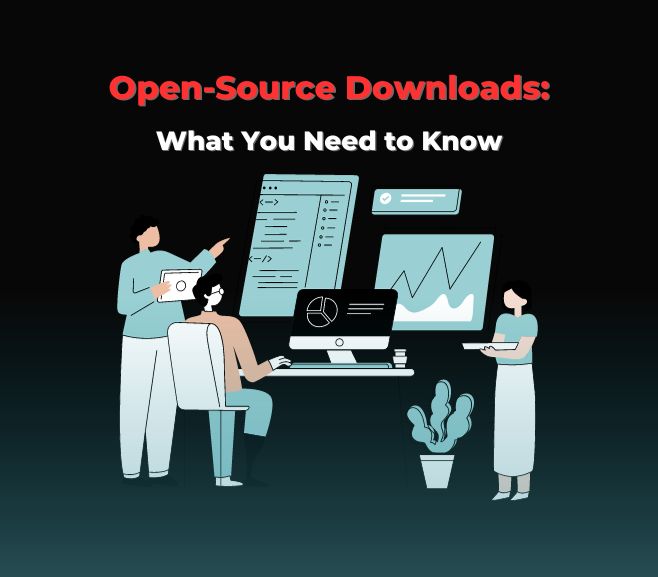In the digital age, open-source software has become a cornerstone of technological innovation. From operating systems to web development frameworks, open-source projects have revolutionized the way we build and use software. However, to fully harness the power of open-source downloads, it’s essential to understand what they entail and how they can benefit you or your business.
The Rise of Open Source
What Is Open Source? Open Source definition
Open source refers to software that is distributed with a license that allows anyone to view, use, modify, and distribute its source code freely. This collaborative approach to software development has given rise to a global community of developers who contribute to and maintain open-source projects. The philosophy behind open source is rooted in transparency, collaboration, and innovation.
Examples of Open Source Software

Open-source software spans a wide range of applications and serves various purposes. Here are some notable examples of open-source software across different categories:
- Operating Systems:
- Linux: A renowned open-source operating system that powers servers, desktops, and mobile devices.
- Ubuntu: An open-source Linux distribution known for its user-friendliness.
- Web Browsers:
- Mozilla Firefox: An open-source web browser famous for its speed, privacy features, and customization options.
- Chromium: The open-source project behind Google Chrome, offering a similar browsing experience.
- Office Suites:
- LibreOffice: An open-source office suite that includes word processing, spreadsheets, presentations, and more.
- Apache OpenOffice: Another open-source office suite offering similar functionality.
- Web Development:
- WordPress: An open-source content management system (CMS) widely used for building websites and blogs.
- Drupal: A robust open-source CMS known for its flexibility and scalability.
- Graphics and Design:
- GIMP (GNU Image Manipulation Program): A powerful open-source image editor, often compared to Adobe Photoshop.
- Inkscape: An open-source vector graphics editor for creating illustrations and graphics.
- Programming and Development:
- Python: An open-source programming language known for its simplicity and versatility.
- Visual Studio Code: A highly customizable open-source code editor developed by Microsoft.
- Database Management:
- MySQL: A popular open-source relational database management system (RDBMS).
- PostgreSQL: An open-source, object-relational database system known for its robustness.
- Content Management Systems (CMS):
- Joomla: An open-source CMS used for building websites and online applications.
- Plone: An open-source CMS designed for managing complex websites and intranets.
- E-commerce:
- Magento: An open-source e-commerce platform that allows businesses to create online stores.
- WooCommerce: An open-source plugin for WordPress, turning it into an e-commerce platform.
- Media Players:
- VLC Media Player: An open-source multimedia player capable of playing a wide range of audio and video formats.
- Kodi: An open-source home theater software for organizing and streaming media content.
- Security and Privacy:
- OpenSSH: An open-source implementation of the SSH (Secure Shell) protocol for secure network communication.
- KeePass: An open-source password manager for securely storing and managing passwords.
- Education:
- Moodle: An open-source learning management system (LMS) used for online education and course management.
- Khan Academy: Offers a collection of open-source educational content and resources.
These are just a few examples of the extensive world of open-source software. Open-source projects continue to drive innovation and provide accessible solutions for individuals, businesses, and organizations across various domains.
Unveiling the Essence of Open Source
Open source, at its core, embodies a fundamental shift in software development. It is a paradigm that champions transparency, collaboration, and innovation. At its essence, open source refers to software that comes bundled with a license that not only permits but actively encourages users to explore, modify, and share its source code freely. This open, democratic approach to software development has given birth to a thriving global community of developers, united by their passion for crafting and maintaining open-source projects.

The Prolific Benefits of Open Source
Cost-Effectiveness: Embrace Savings
One of the most alluring aspects of open-source software lies in its cost-effectiveness. Unlike proprietary software, which often imposes hefty licensing fees, open-source software is generally available free of charge. This translates into significant savings, a boon for individuals and businesses seeking to optimize their budgets without compromising on quality.
Customization: Tailoring Solutions
Open source empowers users with a level of customization that is unparalleled. With access to the source code, developers can embark on a journey of fine-tuning and enhancement, sculpting the software to perfectly align with their unique requirements.
Community Support: A Lifeline
Open-source projects are not solitary endeavors. They flourish within a vibrant community of contributors and users. This communal spirit ensures that when challenges arise or assistance is needed, a supportive network is readily available. This collaborative ecosystem leads to swift problem-solving and continuous innovation.
Decoding Open Source Licenses
GPL (GNU General Public License): A Guardian of Openness
Among the plethora of open-source licenses, the GPL stands as one of the most prominent. This license functions as a guardian of the open-source ethos by enforcing that software derivatives remain open source, thereby nurturing the sustained growth of open-source projects.
MIT License: The Pinnacle of Simplicity
The MIT License is celebrated for its simplicity. It grants users the freedom to modify and distribute the software with minimal constraints, making it a favored choice for countless projects.
Apache License: Balancing Act
The Apache License strikes a harmonious balance between open source and commercial utility. It allows for modifications and distribution while also accommodating commercial applications, making it an enticing option for diverse projects.
Best Practices for Open-Source Downloads
Source Verification: Ensuring Authenticity
Before embarking on any open-source download, it is paramount to verify the authenticity of the source. Stick to reputable websites, official project repositories, or trusted package managers. This meticulous approach ensures that the software you obtain is from a legitimate source, reducing the risk of encountering malware or security vulnerabilities.
Regular Updates: A Pillar of Security
To maintain a secure environment, it is imperative to keep your open-source software up to date. Developers regularly release updates to address security vulnerabilities, enhance performance, and introduce new features. By staying current, you not only benefit from these improvements but also fortify your digital fortress against potential threats.
Contribution and Giving Back: Nurturing the Ecosystem
If open-source software has enriched your digital experience, consider giving back to the community. Whether through code contributions, reporting bugs, or providing financial support, your contributions play a vital role in sustaining the open-source ecosystem. This ensures that the software you rely on continues to flourish.
Open Source in Business: A Strategic Imperative
Enterprise Adoption: A Mark of Excellence
Leading enterprises across the globe are increasingly embracing open-source software. Its reliability, flexibility, and cost-saving attributes make it an irresistible choice. Companies such as Google, IBM, and Facebook actively contribute to open-source projects and incorporate open-source solutions into their operations.
Open Source and Innovation: A Symbiotic Relationship
Open source is a catalyst for innovation across industries. The collaborative sharing of knowledge and concerted effort on open-source projects empowers organizations to expedite the development of cutting-edge technologies, ensuring they remain at the forefront of innovation.
Conclusion
In conclusion, the realm of open source is a vast and ever-evolving landscape. To navigate it successfully and thrive, seize the potential of open-source downloads. By adhering to best practices, understanding the nuances of open-source licenses, and actively participating in the open-source community, you can harness the boundless possibilities that open source offers.




